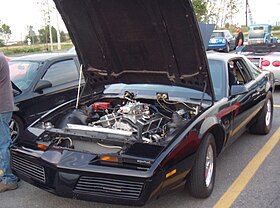Third-generation Pontiac Firebird
| Third-generation Pontiac Firebird | |
|---|---|
 |
|
| Overview | |
| Manufacturer | Pontiac (General Motors) |
| Production | 1981–1992 |
| Assembly |
Van Nuys, California, USA Norwood, Ohio, USA |
| Body and chassis | |
| Class |
Pony car Muscle car |
| Body style | 3-door liftback 2-door convertible |
| Layout | FR layout |
| Platform | F-body |
| Related | Chevrolet Camaro (third generation) |
| Powertrain | |
| Engine |
151 cu in (2.5 L) Pontiac I4 173 cu in (2.8 L) "X" V6 191 cu in (3.1 L) "X" V6 231 cu in (3.8 L) Buick Turbo V6 305 cu in (5.0 L) Chevrolet V8 350 cu in (5.7 L) Chevrolet V8 |
| Transmission | 3-speed automatic THM 200C 4-speed automatic THM 700R4 4-speed manual 5-speed manual Borg Warner T5 6-speed manual |
| Dimensions | |
| Wheelbase | 101 in (2,565 mm) |
| Length | 1990–92 Firebird: 195.1 in (4,956 mm) 1990–92 Trans Am: 195.2 in (4,958 mm) Pre-1988 Firebird: 190.5 in (4,839 mm) Pre-1988 Trans Am: 191.8 in (4,872 mm) |
| Width | 72.4 in (1,839 mm) |
| Height | 49.7 in (1,262 mm) |
The third generation Pontiac Firebird was introduced in late 1981 by Pontiac alongside its corporate cousin, the Chevrolet Camaro for the 1982 model year. These were also the first Firebirds with factory fuel injection, four-speed automatic transmissions, five-speed manual transmissions, four-cylinder engines, 16-inch wheels, and hatchback bodies.
The 3rd Generation of Firebirds consisted of three models: Firebird, Firebird S/E, and Firebird Trans Am. The Firebird was the base model, equivalent to the Camaro Sport Coupe; the Firebird S/E was the luxury version; and the Trans Am, the high-performance version. For 1982, the new Firebird and Camaro had been completely restyled, with the windshield slope set at a dramatic, more aerodynamic 62 degrees, (about 3 degrees steeper than anything GM had ever tried before), flush mounted side glass, and for the first time, a large, glass-dominated rear hatchback. Electronically controlled retractable headlamps, and a rounded hoodline and front fenders were the primary characteristics that distinguished the Firebird from its Camaro sibling and its previous Firebird incarnations. The Firebird would retain hidden headlamps until the end of all production in 2002. Pontiac had also hoped to drop the "Trans Am" moniker from the redesigned cars to save royalties paid to the SCCA for use of the name. Early promotional cars were marked "T/A" as an alternative, however it was decided that doing so might cause more problems than it was worth and the "Trans Am" nameplate remained. Still, with its dimensions reduced, wheelbase shortened, and weight reduced, the Third Generation Firebird was also the closest yet in size to the original 1967 model. It won "Best Sports GT" category in the $11,000 to $14,000 range (also along with the Camaro). Road & Track called the fuel-injected Trans Am "a dramatic improvement on its predecessors," accelerating from 0–60 in 9.2 seconds.
The new Firebird shrank to a 101-inch wheelbase, losing more than 8 inches in overall length, measured about an inch narrower, and weighed nearly 500 lb (227 kg) less than its 1981 predecessor. It also was the most aerodynamic production Firebird to date with a drag coefficient of 0.33. The new Trans Am took things a bit further, with a coefficient of .32. The Trans Am body would continue to improve aerodynamically over the years, and by 1985 would be the most aerodynamic vehicle to ever be released from General Motors with a 0.29 coefficient of drag. Wind tunnels were used to form the 3rd Gen F-Body's shape, and these aerodynamic developments were fully taken advantage of by Pontiac's design team. The sleek new car had a low slung front end which featured split grilles. They fed some air to the radiator but most of the air came from an air dam underneath the front bumper. Every piece of the car was designed to reduce drag. The newly designed side view mirror housings, made of light alloy metal, were almost cone shaped, with the point facing the wind. The windshield wipers were hidden under the hood with the air intake for the climate control system. It made for a smooth flow of air over the windshield. The retractable headlamps popped up from the leading edge of the hood. The cars tended to outlive the plastic gears for the headlight doors, and since the dealers charged several hundred dollars for the repair, it was common to see Firebirds driving around with one or both headlights stuck open during the day. Smooth wheelcovers were available on the Trans Am, attached to turbine finned alloy wheels. A frameless, flush mounted, compound curved rear glass hatchback decklid provided 30.9 cu ft (0.87 m3). of cargo space with the rear seats folded, and an optional wiper. It provided no disturbance to the airflow over the back of the car. All of these features combined together to provide a low coefficient of drag. The front end of the vehicle featured 10.5-inch-diameter (270 mm) power disc brakes and were now made standard on all Firebird models. Taking styling cues from the 1981 design, the new car had full width tail lights, complete with a Firebird emblem in the center. The all-new suspension design was more advanced and aggressive than anything Detroit had offered previously, easily rivaling the Corvette's handling abilities, (but not its sophistication). The front suspension utilized MacPherson struts, with inboard mounted coil springs and lower front control arms. In the rear, coil springs and shocks were positioned between the body and solid rear axle, with twin rear lower control arms/trailing links and a torsion bar, replacing the old-fashioned leaf springs design used previously in the 2nd Gens. A huge torque arm was mounted from the transmissions tailshaft to the rear axle center to further stabilize the axle's tendency to twist.
...
Wikipedia
